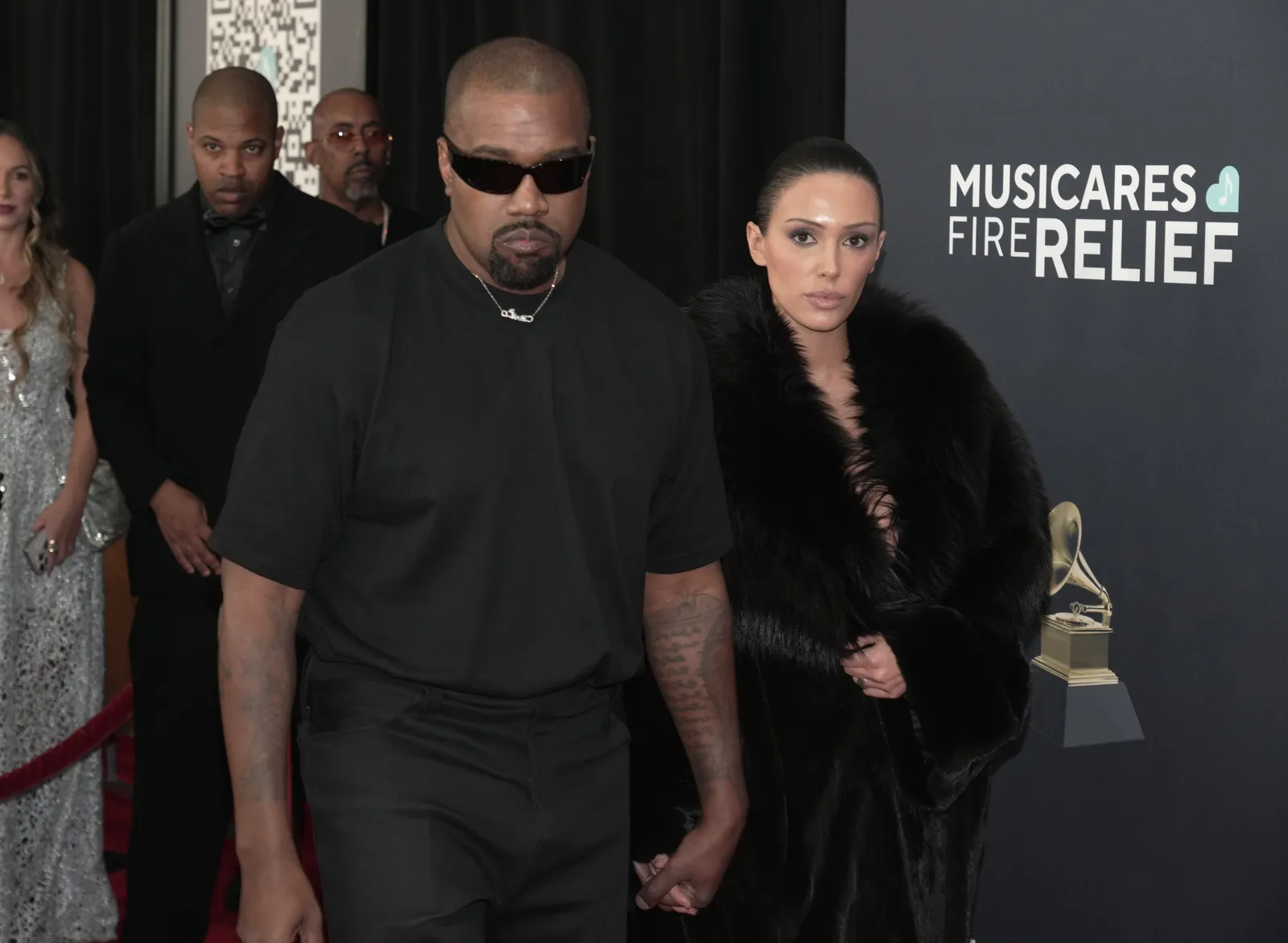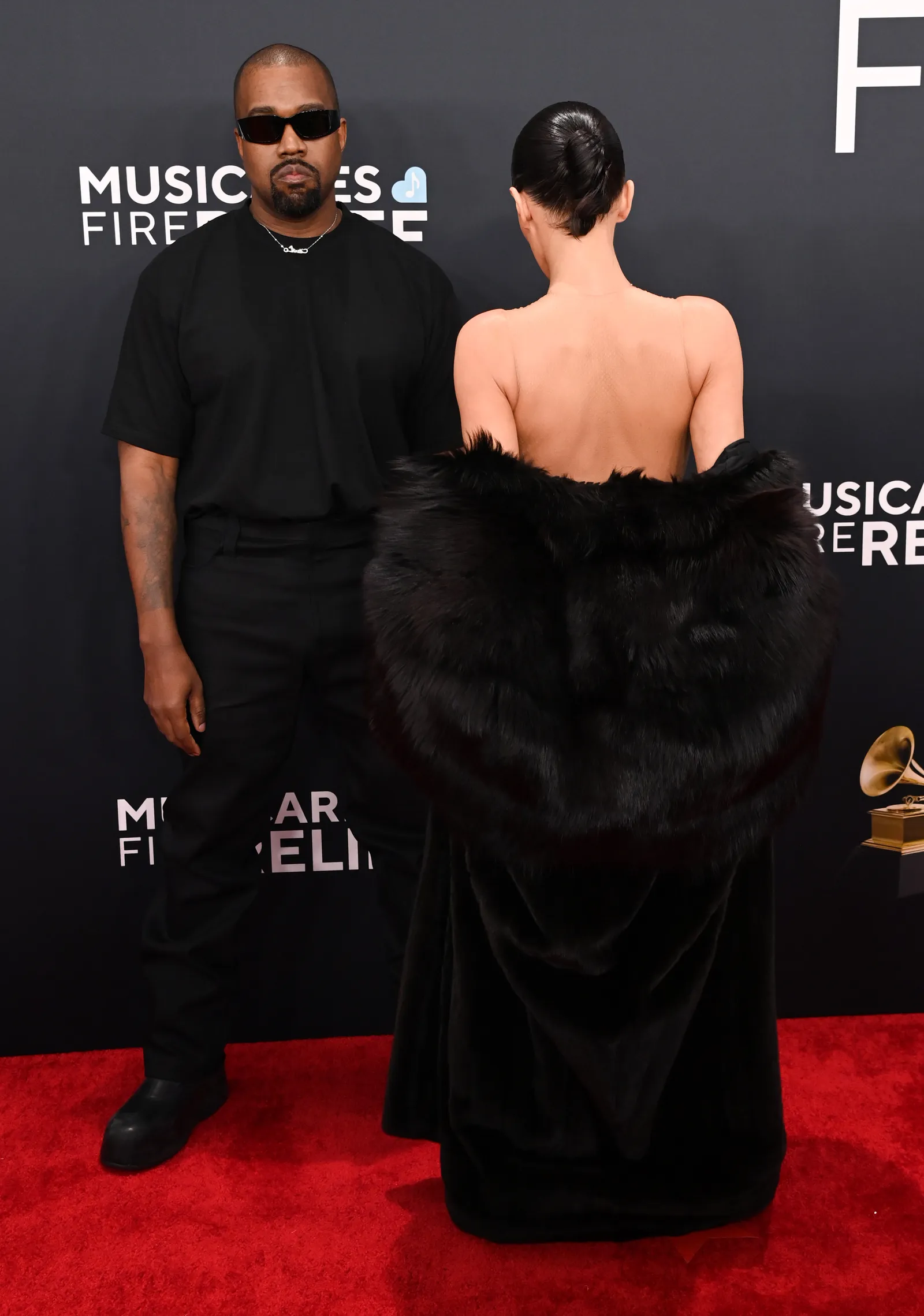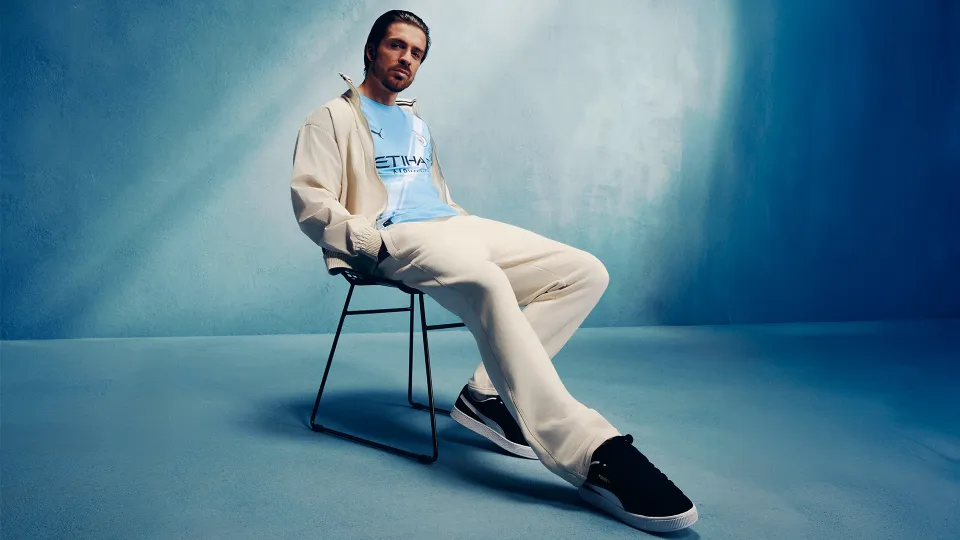Kanye West and Bianca Censori made headlines on Sunday night with a bold and polarizing appearance on the red carpet of the 2025 Grammy Awards. Hosted in Los Angeles, the star-studded event was expected to deliver glamour, high fashion, and musical excellence. But no one anticipated the sartorial bombshell the couple would drop—one that’s now ignited fierce conversations across the fashion, music, and pop culture landscape.
This marked West’s first Grammys appearance in ten years, and his return was as controversial as it was calculated. Not only did he arrive nominated—his track Carnival, created with Ty Dolla $ign under their ¥$ moniker, scored a nod for Best Rap Song—but he also arrived in the company of a woman whose outfit (or lack thereof) redefined the concept of red carpet fashion.
The Entrance That Stole the Show
Bianca Censori’s Barely-There Ensemble
Censori, Kanye West’s wife since 2022, stunned photographers and onlookers alike by wearing a sheer, body-hugging minidress made from pantyhose material. The ensemble left little to the imagination. Thin, translucent, and practically invisible under stage lights, the dress clung to her frame with surgical precision. She initially arrived covered in a dark, floor-length fur coat. But after posing briefly beside West, Censori turned away from the cameras and shrugged off the coat—revealing the sheer outfit to a gasping crowd. A nearby staff member quickly whisked the coat away, making it clear that the moment was planned and staged for maximum effect.
The absence of visible undergarments only heightened the drama. This was not merely a risqué look—it was an intentional challenge to the unspoken boundaries of red carpet fashion, pushing the limits of what constitutes attire in a space typically reserved for high couture.
Kanye West’s All-Black Uniform
In stark contrast to his wife’s shock-inducing fashion choice, Kanye West played the role of the silent partner in darkness. Dressed head-to-toe in black—pants, T-shirt, and his trademark sunglasses—he evoked a subdued, almost utilitarian aesthetic. The look was devoid of flash or embellishment, allowing Censori to command full attention.
Still, this too was a carefully curated decision. Kanye’s monochrome minimalism served as a perfect foil to Censori’s radical transparency. Together, they composed a visual tension: concealment versus exposure, shadow versus light, uniformity versus vulnerability.
The Fashion Message: Nudity as Commentary?
The Rise of the “Non-Dress” Dress
Bianca Censori’s look joins a growing movement of celebrity fashion choices that blur the line between clothing and nudity. In an era where naked dresses are now commonplace on red carpets—from Florence Pugh’s sheer Valentino gowns to Megan Fox’s barely-there designs—Censori’s take stands out by going a step further. Her dress didn’t just simulate nudity—it practically embodied it.
This raises an important question: was this look a provocative stunt, a statement on modern exhibitionism, or both?
Censori has worn similarly revealing outfits in public before, often made from the same sheer nylon or mesh-like materials. But the Grammys—arguably the biggest night in music—offered a global stage. Her decision to double down on a barely-there aesthetic speaks to a deeper commentary on visibility, sexuality, and control.
The Politics of Body Exposure
The decision to wear such a revealing ensemble is never just about fashion—it’s political. In choosing to bare nearly all, Censori aligns herself with a lineage of women in the public eye who’ve used nudity to reclaim power, provoke dialogue, or destabilize expectations.
Figures like Cher, Madonna, and even Lady Gaga have made entire careers around subversive costuming. But Censori’s appearance shifts the conversation into a more complex space—one shaped by social media, constant surveillance, and a culture obsessed with the female form.
Her decision also invites reflection on double standards. Would a male artist be celebrated—or shamed—if he appeared wearing nothing but sheer fabric? In a world still governed by puritanical attitudes toward women’s bodies, this type of fashion statement demands to be viewed through a critical lens.
Kanye’s Role: Supporter or Strategist?
A Calculated Return
Kanye West’s decision to return to the Grammys after a decade-long absence was already newsworthy. The rapper and fashion icon has long held a contentious relationship with award shows, often criticizing their biases and gatekeeping tendencies. His 2025 nomination—alongside Ty Dolla $ign under the name ¥$—signals a new chapter in his evolving musical identity.
But his reappearance wasn’t just about music. It was about visual theater.
West is no stranger to using fashion as performance. From his early days in shutter shades and pink polos to the minimalist, utilitarian silhouettes of his Yeezy brand, Kanye has always understood the power of the image. By pairing his silent, almost monk-like aesthetic with Censori’s explosive transparency, he created a juxtaposition that placed him squarely back into the cultural spotlight.
The Dynamic Between West and Censori
The couple’s red carpet dynamic also sparked speculation. Was Censori’s look entirely her own, or part of a larger vision orchestrated by West? Given his history of influencing (and often dictating) the fashion choices of his partners, the speculation isn’t unwarranted.
Still, recent interviews suggest that Censori has embraced this provocative aesthetic on her own terms, using it as a form of creative self-expression. Whether a muse or a co-architect of these fashion moments, her agency deserves recognition. The Grammys red carpet was not merely an accessory to Kanye’s narrative—it was also hers.
The Grammys, Spectacle, and Public Outrage
The Role of Outrage in Red Carpet Culture
The Grammys red carpet is often a place where fashion meets performance art. Artists understand that the spectacle isn’t confined to the stage—it begins the moment they step out of their limo. In this context, Censori’s choice was not out of place—it was right on cue.
Fashion that provokes outrage tends to dominate headlines. Social media lit up instantly, with opinions split between admiration, confusion, and condemnation. Critics called it tasteless. Supporters called it fearless. Everyone, however, was talking.
That’s the currency of 21st-century celebrity—visibility and virality.
Media, Morality, and the Line Between Style and Stunt
Responses to Censori’s look reveal as much about public sentiment as they do about the couple themselves. Some questioned whether it was appropriate for a formal event, while others celebrated the disruption of rigid dress codes. The polarizing reaction underscores a broader tension in fashion today: the push and pull between creative freedom and social norms.
Whether the look qualifies as high art or tabloid fodder may depend less on its construction and more on its intent. But in a world where celebrity actions are endlessly dissected, intent is often beside the point. Impact is what matters—and this look delivered it in spades.
The Bigger Picture: Redefining Celebrity Image-Making
The New Era of Fame
What West and Censori’s Grammys moment reveals is the evolution of fame itself. No longer defined solely by work or talent, celebrity today is constructed through narrative control, spectacle, and aesthetic innovation. Every appearance, every outfit, every red carpet walk is a brushstroke on a larger canvas of self-branding.
Their look wasn’t just a “fashion moment.” It was a multimedia event.
In this sense, Censori joins a lineage of female figures who’ve rewritten public personas through wardrobe: from Marilyn Monroe’s sheer sequins to Kim Kardashian’s 2021 Met Gala blackout look. She isn’t simply a spouse in Kanye’s orbit—she’s an architect of her own mythology.
The Music: Lest We Forget
¥$ and the Success of Carnival
Amid the fashion frenzy, it’s easy to forget that Kanye West attended the Grammys this year as a nominee. His track Carnival, a collaborative effort with Ty Dolla $ign under their group moniker ¥$, received critical acclaim for its innovative production and introspective lyrics. The duo’s sonic chemistry breathed new life into the genre, blending West’s iconic sampling style with Ty’s melodic instincts.
The nomination for Best Rap Song reaffirmed West’s relevance in an industry he once dominated and frequently criticized. Win or lose, the nomination was symbolic—a reminder that beneath the drama, he remains a formidable musical force.
Final Reflections: Iconic, Infamous, or Irrelevant?
The Power and Peril of Provocation
Whether you consider Kanye West and Bianca Censori’s Grammys appearance iconic, infamous, or irrelevant may depend on your tolerance for provocation. What’s clear is that it was intentional, theatrical, and executed with an understanding of how to dominate discourse.
In a media landscape oversaturated with content, few moments genuinely cut through. This one did.
Rewriting the Rules, One Outfit at a Time
Censori’s look will be dissected for months. Was it a fashion revolution or a calculated shock? Was it empowering or exploitative? These questions, though uncomfortable, are necessary. They force us to interrogate our own values around fashion, femininity, and the spectacle of celebrity.
But perhaps the most compelling takeaway is this: in a world where fame is as much about control as creativity, Kanye West and Bianca Censori proved they still know how to seize the moment—and define it on their own terms.
- Evan Name Meaning - June 5, 2025
- Virginia’s Most Popular THC Infused Drinks - June 5, 2025
- Nebraska’s THC Infused Seltzer Recommendations - June 4, 2025







